June 20th Scots Book of Days
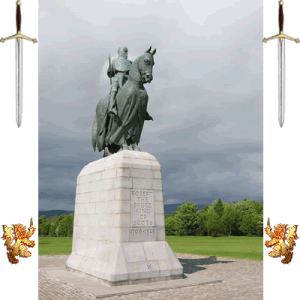 June 20 1306 Battle of Methven Perth Scotland day after. Tytler’s Britannica 47. The Bruce escaped with 500 men. From Athole, Bruce retreated to Aberdeenshire. The queen and ladies joined their husbands and fathers as fugitives, to share the perils. Attempting Argyle, they were repulsed. Tytler’s Britannica. The English were to regret their dilatory response.
June 20 1306 Battle of Methven Perth Scotland day after. Tytler’s Britannica 47. The Bruce escaped with 500 men. From Athole, Bruce retreated to Aberdeenshire. The queen and ladies joined their husbands and fathers as fugitives, to share the perils. Attempting Argyle, they were repulsed. Tytler’s Britannica. The English were to regret their dilatory response.
methvenonline.co.uk.
Two centuries later, circa 1527, the widowed Dowager Queen Mother Margaret Stewart (nee Tudor, Douglas), will prevail upon her son James 5th King, to ennoble Margaret’s 3rd husband Henry Stewart as Lord Methven (by then, James’ step father). Younger brother to Lord Ochiltree, one of the 24 Lords of the Congregation.
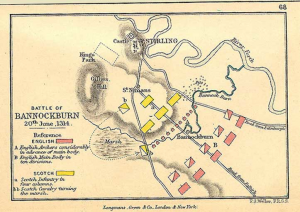 1314 Battle of Bannockburn. Battle of Bannockburn, 20th June 1314. Stiriing, Castle, Bannock Burgh, Bannockburn, Marsh, Kings Park, Gillies Hill [Servants], River Forth, Road from Edinburgh, Road from Falkirk, Reference English Archers considerably in advance of main body [Red slash white]. English Main Body in ten divisions [Red]. SCOTCH infantry in four columns, St. Ninians, Scotch Cavalry turning the marsh. [Scotch Enveloped the English divisions from the side rear resulting in panic. Then the Gillies (servants) appeared from where they were waiting over their hill to complete the rout of the English divisions. The English mostly abandoned their weapons and fled. Many drowned. Scotch victory insured Scotch independence for another two and a half centuries.]
1314 Battle of Bannockburn. Battle of Bannockburn, 20th June 1314. Stiriing, Castle, Bannock Burgh, Bannockburn, Marsh, Kings Park, Gillies Hill [Servants], River Forth, Road from Edinburgh, Road from Falkirk, Reference English Archers considerably in advance of main body [Red slash white]. English Main Body in ten divisions [Red]. SCOTCH infantry in four columns, St. Ninians, Scotch Cavalry turning the marsh. [Scotch Enveloped the English divisions from the side rear resulting in panic. Then the Gillies (servants) appeared from where they were waiting over their hill to complete the rout of the English divisions. The English mostly abandoned their weapons and fled. Many drowned. Scotch victory insured Scotch independence for another two and a half centuries.]
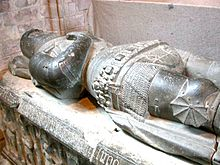 1405 Alexander Stewart, 2nd Earl of Buchan, Alasdair Mór mac an Rígh, Lord of Badenoch, and the Wolf of Badenoch (1343 – 20 June 1405), was the third surviving son of King Robert II of Scotland and youngest by his first wife, Elizabeth Mure of Rowallan.
1405 Alexander Stewart, 2nd Earl of Buchan, Alasdair Mór mac an Rígh, Lord of Badenoch, and the Wolf of Badenoch (1343 – 20 June 1405), was the third surviving son of King Robert II of Scotland and youngest by his first wife, Elizabeth Mure of Rowallan.
Stewart’s sarcophagus-effigy at Dunkeld Cathedral, Perthshire, where he was buried. His chest tomb, topped by an effigy in armour, is one of the few Scottish royal monuments to have survived from the Middle Ages. Wikipedia. http://fabpedigree.com/s094/f084517.htm
1411 about a month before Harlaw. The Battle of Dingwall was a Scottish clan battle said to have taken place in the year 1411, in Dingwall, Ross and Cromarty, in the Scottish Highlands. King Macbeth was born in Dingwall circa 1005. Macbeth’s father was Findláech mac Ruaidrí, Mormaer of Moray. Macbeth’s mother is believed to have been Donada, who was the second daughter of Malcolm II, who was King of Scots between 1005 and 1034. 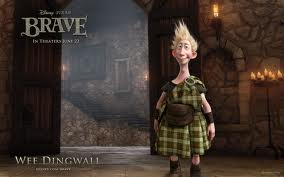 MacBeth ruled as King of Scots from 1040 until his death in 1057. King Alexander II created Dingwall a royal burgh in 1226, and King James IV (reign 1488 to 1513) renewed its charter. A fictionalized Wee Dingwall heir is featured in Brave (2012 Disney film). Depicted here in his kilt, belt over the shoulder, leather Sporran pouch around waist, knee high hose, no head gear.
MacBeth ruled as King of Scots from 1040 until his death in 1057. King Alexander II created Dingwall a royal burgh in 1226, and King James IV (reign 1488 to 1513) renewed its charter. A fictionalized Wee Dingwall heir is featured in Brave (2012 Disney film). Depicted here in his kilt, belt over the shoulder, leather Sporran pouch around waist, knee high hose, no head gear.
- Dingwall was fought between the Clan Mackay against the Clan Donald. In 1403 the Battle of Tuiteam Tarbhach was fought between Clan Mackay and Clan MacLeod of Lewis. In 1406 a party of Macleods of Lewis were defeated at the battle of Tuiteam Tarbhach against a party of Mackays. By 1500 Torquil MacLeod was the most notable of the chiefs who resisted the efforts of the king’s lieutenants, first his
 brother-in-law, Archibald Campbell, 2nd Earl of Argyll,
brother-in-law, Archibald Campbell, 2nd Earl of Argyll,
o Campbell Earl of Argyll 1010 2Montgomery2Blair 2Cochrane2Miller 2Simmons2Choate to zoe TOAG and afterwards Alexander Gordon, 3rd Earl of Huntley.
Macleod of the Lewes Crest: The sun in splendor, Proper.[ Motto: I BIRN QUHIL I SE. Badge: red whortleberry. Chief: Torquil MacLeod of the Lewes
1654 STRANG, DR. JOHN, died. A 17th century divine, son of Mr. William Strang, minister of Irvine, in Ayrshire, where he was born in 1584. In 1613 Strang became minister of Errol, in the presbytery of Perth. IN 1616, at the recommendation of James VI., Strang and several other persons were invested with the degree of D.D. Doctor of Divinity at St. Andrews. In 1618 Strang voted against the five articles of Perth. In 1626 Strang was appointed principal of the university of Glasgow,
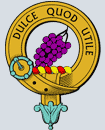 Strang Chief: Timothy Strange of Balcaskie. Motto: Dexter Dulce Quod Utile – ‘That Which Is Useful Is Sweet
Strang Chief: Timothy Strange of Balcaskie. Motto: Dexter Dulce Quod Utile – ‘That Which Is Useful Is Sweet
Strang/ Strong/ Strange , Norse – Strangi and the Norman Le Strange meaning Stranger/Foreigner. In Orkney the name generally takes the form Strong, while in the Lowlands it is found as Lestrange, Strange, Strang as well as Strong. In 1255 being that of Home le Estraunge who was in the service of Alexander II. A William Strange is Burgess of Montrose in 1296, Thomas de Strang had land near Aberdeen in 1340 and in 1398, John Strang was elected a common councilor there. Fifeshire. In 1542 Sir George Strang was a cleric and notary in Orkney
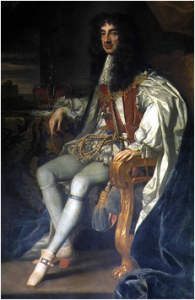 1685 – Monmouth Rebellion: James Scott, 1st Duke of Monmouth declares himself King of England and Scotland at Bridgewater, Somerset. Monmouth loses out to James 2nd, uncle and Duke of York. James Scott Duke of Monmouth, Stanford.edu.
1685 – Monmouth Rebellion: James Scott, 1st Duke of Monmouth declares himself King of England and Scotland at Bridgewater, Somerset. Monmouth loses out to James 2nd, uncle and Duke of York. James Scott Duke of Monmouth, Stanford.edu.
1697 The Darien colony. Sometime in June.
Scotland, left to her unassisted resources, would have acted with less spirit but more wisdom, in renouncing her ambitious plan of colonization, sure as it now was to be thwarted by the hostile interference of her unfriendly but powerful neighbour and rival [England]. But those engaged in the scheme, comprising great part of the nation, could not be expected easily to renounce hopes which had been so highly excited, and enough remained of the proud and obstinate spirit with which their ancestors had maintained their independence, to induce the Scots,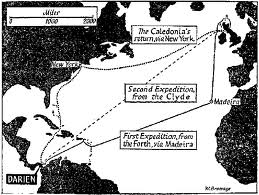 even when thrown back on their own limited means, to determine upon the establishment of their favourite settlement at Darien, in spite of the desertion of their English and foreign subscribers, and in defiance of the invidious opposition of their powerful neighbours. They caught the spirit of their ancestors, who, after losing so many dreadful battles, were always found ready with sword in hand, to dispute the next campaign. Trips to Darien. Kinnaird.net. Mosquito born yellow fever would not be a isolated until about 1901. Before that, Darien was a death camp of fever, which explained why neither native Indian nor Spanish nor Portuguese had been able to colonize the area. The name Darien was picked up as town names in Georgia, and Connecticut (circa 1822).
even when thrown back on their own limited means, to determine upon the establishment of their favourite settlement at Darien, in spite of the desertion of their English and foreign subscribers, and in defiance of the invidious opposition of their powerful neighbours. They caught the spirit of their ancestors, who, after losing so many dreadful battles, were always found ready with sword in hand, to dispute the next campaign. Trips to Darien. Kinnaird.net. Mosquito born yellow fever would not be a isolated until about 1901. Before that, Darien was a death camp of fever, which explained why neither native Indian nor Spanish nor Portuguese had been able to colonize the area. The name Darien was picked up as town names in Georgia, and Connecticut (circa 1822).
1723 – Adam Ferguson, born, Scottish philosopher and historian (d. 1816). Born at Logierait in Atholl, Perthshire, Scotland, he received his education at Logierait Parish School, Perth Grammar School, and at the University of Edinburgh and the University of St Andrews (MA 1742). In 1745, owing to his knowledge of Gaelic, he gained appointment as deputy chaplain of the 43rd (afterwards the 42nd) regiment (the Black Watch),
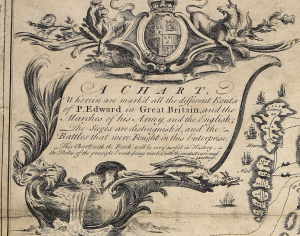 1745 June 20. ITINERARY OF PRINCE CHARLES EDWARD STUART FROM HIS LANDING IN SCOTLAND July 1745 TO HIS DEPARTURE IN SEPTEMBER 1746 Compiled from THE LYON IN MOURNING supplemented and corrected from other contemporary sources by WALTER BIGGAR BLAIKIE – EDINBURGH
1745 June 20. ITINERARY OF PRINCE CHARLES EDWARD STUART FROM HIS LANDING IN SCOTLAND July 1745 TO HIS DEPARTURE IN SEPTEMBER 1746 Compiled from THE LYON IN MOURNING supplemented and corrected from other contemporary sources by WALTER BIGGAR BLAIKIE – EDINBURGH
Printed at the University Press by T. and A. CONSTABLE for the Scottish History Society, 1897 .Map and ITINERARY [The dates are Old Style throughout, meaning contemporaneous.]
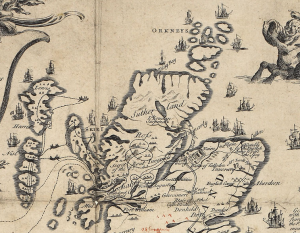 1746 June 20 Donald MacLeod, who here parted from the Prince,
1746 June 20 Donald MacLeod, who here parted from the Prince,
was taken prisoner a fortnight later (I. 178). Publications OF THE SCOTISH HISTORY SOCIETY VOLUME XXIII, Pg 66 (52) April 1897 SUPPLEMENT LYON IN MOURNING PRINCE CHARLES EDWARD STUART ITINERARY AND MAP. Ed.W. B. BLAIKIE, from Narrative of Lord MacLeod, son of the Earl of Cromarty
Lewis, Orkneys, Skye
1755 Battle of Monongahela River 1755 – Braddock’s Defeat, Fort Duquesne, western Pennsylvania Colony. The French and Indian War also known as the Seven Year War (1757 to 1762). army reached Bear Camp where George Washington was left, extremely ill. Washington rejoined the army on 8th July in time to take a heroic part in the battle.
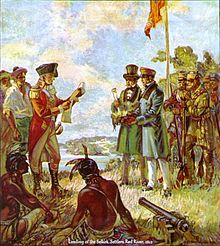 1771 – Thomas Douglas, 5th Earl of Selkirk born, Scottish philanthropist (d. 1820). Douglas was the seventh son of Dunbar Douglas, 4th Earl of Selkirk, and his wife Helen Hamilton (1738-1802), grand-daughter of Thomas Hamilton, 6th Earl of Haddington.
1771 – Thomas Douglas, 5th Earl of Selkirk born, Scottish philanthropist (d. 1820). Douglas was the seventh son of Dunbar Douglas, 4th Earl of Selkirk, and his wife Helen Hamilton (1738-1802), grand-daughter of Thomas Hamilton, 6th Earl of Haddington.
- [Hamilton 2Stewart 2Millar 2simmons 2Choate 2Sorensen]
Landing of the Selkirk Settlers, Red River, 1812 Manitoba. Earl Selkirk bought shares to control the Hudson’s Bay Company and settle Highland farmers in upper Canada, and Winnipeg. Robert Semple was appointed as governor of the Red River Colony, circa 1814.
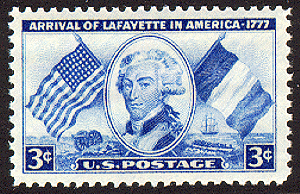 1781 General Charles Cornwallis (son married a Cochrane daughter) did not pursue Lafayette; instead, Cornwallis sent raiders into central Virginia, attacking depots and wrecking supply convoys, before recalling them on June 20.
1781 General Charles Cornwallis (son married a Cochrane daughter) did not pursue Lafayette; instead, Cornwallis sent raiders into central Virginia, attacking depots and wrecking supply convoys, before recalling them on June 20.
1952 June 13 issue. Marquis de Lafayette 175th anniversary. The Marquis de Lafayette, a French general who defied his government and came to America to offer his services in the American Revolution, is also known for his later action in the French Revolution. A friend of George Washington, he served with Washington at the Battle of Brandywine and at Valley Forge. In 1779 he returned to France to expedite the dispatch of a French army, and returned in time to distinguish himself at the battle of Yorktown in 1781. Lafayette won popularity in America.. He was imprisonment by Austria until he was freed in 1799 at the behest of Napoleon. In 1815 Lafayette was one who demanded Napoleon (1st’s) abdication. Lafayette made a triumphant tour of the United States in 1824. usstampgallery.com
The auld alliance between France and Scottish descendants in America, was renewed during the War for Independence
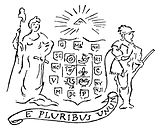 1782 – The U.S. Congress adopts the Great Seal of the United States. In August,1776, Pierre Eugene
1782 – The U.S. Congress adopts the Great Seal of the United States. In August,1776, Pierre Eugene 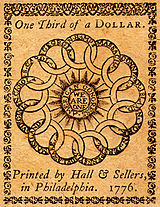 Du Simitière, a Philadelphia artist, recruited by Franklin, Jefferson and Adams, showed his design, which was more along conventional heraldic lines. The shield had six sections, each representing “the Countries from which these States have been peopled” (England, Scotland, Ireland, France, Germany, and Holland), surrounded by the initials of all thirteen states.
Du Simitière, a Philadelphia artist, recruited by Franklin, Jefferson and Adams, showed his design, which was more along conventional heraldic lines. The shield had six sections, each representing “the Countries from which these States have been peopled” (England, Scotland, Ireland, France, Germany, and Holland), surrounded by the initials of all thirteen states.
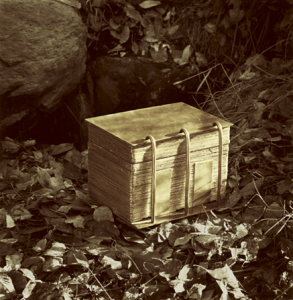 1829 Joseph Smith the Prophet, at Fayette, New York, (clans Huntley, Hamilton, Mackenzie, Mack of Inverness, Malcolm King of Scots). Doctrine and Covenants 17. Sometime in June. ‘You shall have a view of the plates, and also of the breastplate, the sword of Laban, the Urim and Thummim, which were given to the brother of Jared upon the mount, when he talked with the Lord face to face, and the miraculous directors which were given to Lehi while in the wilderness, on the borders of the iRed Sea.’
1829 Joseph Smith the Prophet, at Fayette, New York, (clans Huntley, Hamilton, Mackenzie, Mack of Inverness, Malcolm King of Scots). Doctrine and Covenants 17. Sometime in June. ‘You shall have a view of the plates, and also of the breastplate, the sword of Laban, the Urim and Thummim, which were given to the brother of Jared upon the mount, when he talked with the Lord face to face, and the miraculous directors which were given to Lehi while in the wilderness, on the borders of the iRed Sea.’
lds.org. A painting of the gold plates from a written description.
1837 King William IV died, age 73, 7th year of reign. His niece Princess Victoria, daughter of the Duke of Kent becomes Queen. Tytler’s Britannica.
1850 Letter from ‘A Highland Agriculturist’ published as “The Highland Emigrations”. Inverness Courier. Potato Famine, hundreds starve, thousands emigrate. The Scottish Poor Laws, unlike those in England, allowed relief to be given from the parish poor rates only to the sick and infirm and explicitly forbade any relief being given to the able-bodied poor unable to find work locally. As early as 1848 Sir Charles Trevelyan had advocated that the Scottish Poor Law be amended to allow the able-bodied poor to claim relief; critics countered that the scale of destitution was such that it was clearly unrealistic to expect a large number of unemployed in a distressed parish to be supported solely by rates levied on that parish. Wikipedia.
1863 West Virginia statehood, Scottish place names include (Wikipedia)-
Aberdeen, Glasgow, Glenville, Henderson, McDowell County, Montrose. In the middle of a great civil war, these counties of Virginia refused secession, and obtained statehood.
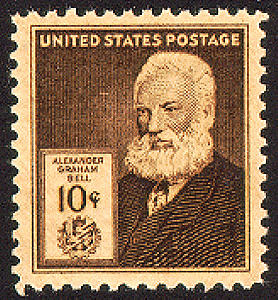 1877 – Alexander Graham Bell installs the world’s first commercial telephone service in Hamilton, Ontario, Canada. (clans Graham and Bell).
1877 – Alexander Graham Bell installs the world’s first commercial telephone service in Hamilton, Ontario, Canada. (clans Graham and Bell).
Bell 1940. The story goes Western Union was offered the patents on the phone for $100,000 but turned it down as the telegraph monopoly was too good, and they didn’t need voice service.
/usstampgallery.com/search.php?st=scottish
1945 Abbott and Costello film The Naughty Nineties features Costello auditions for Captain Sam’s riverboat show by singing Scottish folk song My bonnie Lies over the Ocean. Wikipedia- Obscure origin may be Charles Edward Stuart (‘Bonnie Prince Charlie’) after the defeat of the Prince at the Battle of Culloden in 1746 and his subsequent exile. My Bonnie lies over the ocean
My Bonnie lies over the sea
My Bonnie lies over the ocean
Oh, bring back my Bonnie to me…
Bring back, bring back
Oh, bring back my Bonnie to me, to me
Disclaimer: The author of each article published on this web site owns his or her own words. The opinions, beliefs and viewpoints expressed by the various authors and forum participants on this site do not necessarily reflect the opinions, beliefs and viewpoints of Utah Standard News or official policies of the USN and may actually reflect positions that USN actively opposes. No claim in public domain or fair use. © John Choate
Utah Standard News depends on the support of readers like you.
Good Journalism requires time, expertise, passion and money. We know you appreciate the coverage here. Please help us to continue as an alternative news website by becoming a subscriber or making a donation. To learn more about our subscription options or make a donation, click here.
To Advertise on UtahStandardNews.com, please contact us at: ed@utahstandardnews.com.


Comments - No Responses to “June 20th Scots Book of Days”
Sure is empty down here...